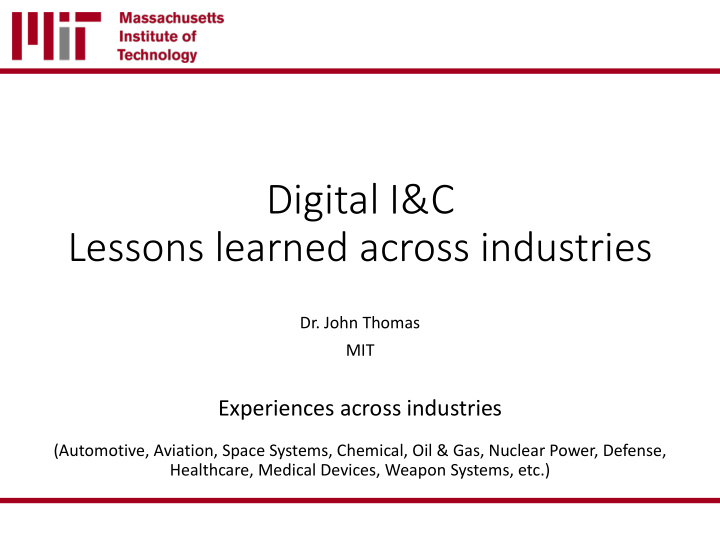



Digital I&C Lessons learned across industries Dr. John Thomas MIT Experiences across industries (Automotive, Aviation, Space Systems, Chemical, Oil & Gas, Nuclear Power, Defense, Healthcare, Medical Devices, Weapon Systems, etc.)
Accidents causes are changing Non-failure accidents Non-failure accidents Component failure Component failure accidents accidents 1970s Today
Barrier: requirements • “The hardest single part of building a software system is deciding precisely what to build .” -- Fred Brooks, The Mythical Man-Month • Most software-related accidents have been traced to flaws in the requirements (Leveson, 2004) (Endres et al., 2003)(Lutz et al., 1993) • “ As is well known to software engineers, by far the largest class of problems arises from errors made in the eliciting, recording, and analysis of requirements ” (Jackson et al., 2007) 3
Insight from Automotive • “In my experience the requirements are much more important than preventing hardware failures. recalls are rarely due to component failures, typically it’s due to missed requirements, requirements never verified, or missed interaction with supplier.” • Joseph Miller 4
HPCI Flow Control System
Operating Experience (No Component Failures) Governor Valve Governor Valve Position Turbine Speed Turbine Speed Reset Setpoint Time
Operating Experience (No Component Failures) System Enable “Trip” Governor Valve Position Signal (17%) Setpoint Turbine Speed System Initiation Signal (0%) Reset Setpoint Time
Blind test of STPA Process Plant Operator Model Conditions Select Set Desired Adjust System Select Auto Desired Controller Flow Rate Flow Flow or Manual Speed (MCR/RSP) (Auto) (Manual) Rate Process Flow Control System Model System Initiation Signal System Turbine Valve Open/Close System Flow Rate Speed Position Commands Enable M Actuator LS From Main Steam FLOW Governor Steam Trip/ Magnetic Valve Admission Throttle PickUp Valve Valve To From Torus or Reactor Condensate Storage Tank Controlled Process
Blind test: STPA identified the problem Hazard: Equipment Operated Beyond Limits (H3) Controller: HPCI-RCIC Flow Control System Hazardous Control Action No. 2: “Increase governor valve position” command is provided when: there is an accident and turbine speed is too high, regardless of system flow Inadequate, Missing or Delayed Feedback Enable signal sent to controller before there is a valid demand on HPCI/RCIC enable provided when steam admission valve is not open (broken or misaligned LS) steam admission valve commanded open when there is no demand on HPCI/RCIC (spurious ESFAS signal) Enable signal sent to controller when there is a demand on HPCI/RCIC, but delayed enable provided when steam admission valve is opened, but too late (misaligned LS or LS setpoint too high) steam admission valve opens too slowly when commanded by ESFAS Initiation Signal (excessive stem thrust) steam admission valve commanded open too late when there is a demand on HPCI/RCIC (ESFAS delay) HPCI/RCIC pump flow rate signal to controller is missing, delayed, incorrect, too infrequent, or has inadequate resolution Signal corrupted during transmission sensor failure sensor design flaw sensor operates correctly but actual flow rate is outside sensor’s operating range fluid type is not as expected (water vs. steam?) Governor valve position signal to controller is missing, delayed, incorrect, too infrequent, or has inadequate resolution Problems with communication path actual position is beyond sensor’s range sensor reports actuator position and it doesn’t match valve position sensor correctly reports valve position but position doesn’t match assumed area/shape
Industry standards to solve this problem • ISO/PAS 21448: Safety of the Intended Functionality (SOTIF) • STPA used assess safety of digital systems • ASTM WK60748 • “Standard Guide for Application of STPA to Aircraft” • SAE AIR6913 • “Using STPA during Development and Safety Assessment of Civil Aircraft” • RTCA DO-356A • “Airworthiness Security Methods and Considerations” • STPA-sec used for cybersecurity of digital systems • SAE JXXXX • “Recommended Practice for STPA in Automotive Safety Critical Systems” (Last Slide)
Recommend
More recommend